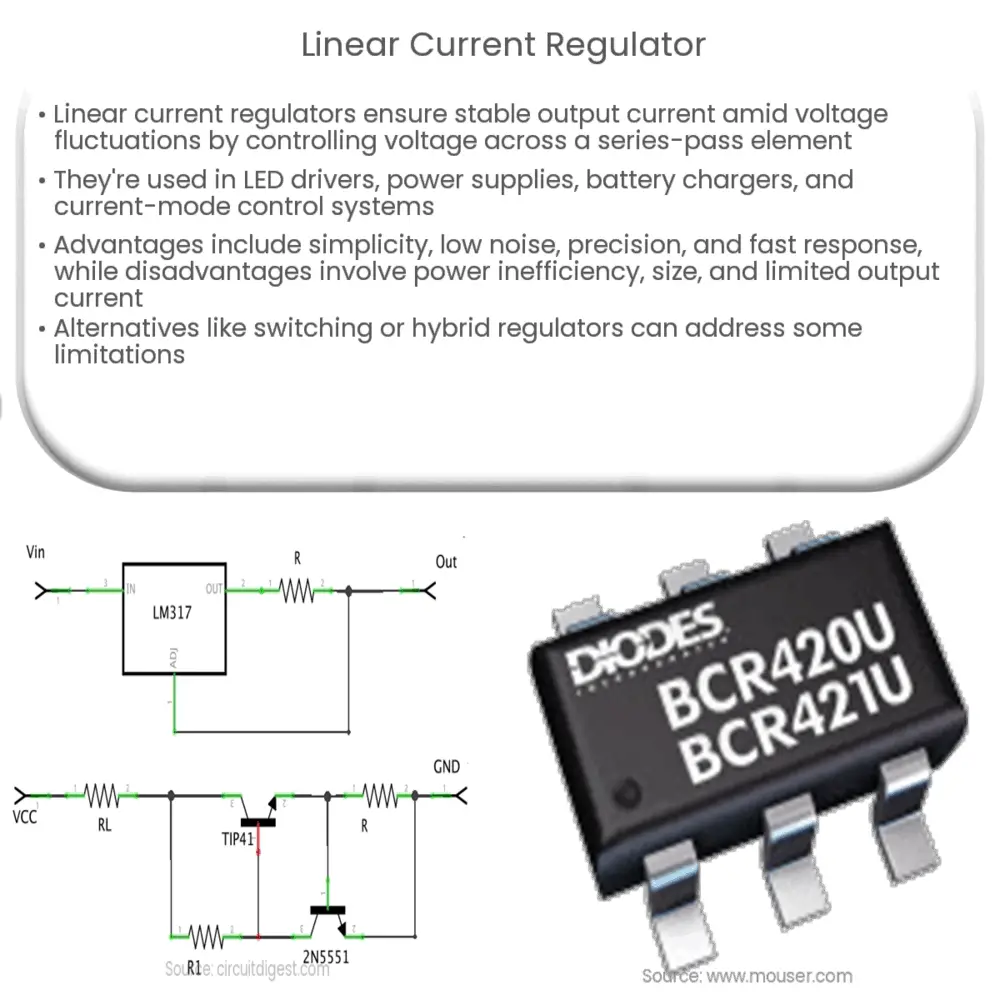A linear current regulator ensures a stable output current in electronic systems, compensating for input voltage fluctuations and load changes.

Linear Current Regulator: An Overview
Introduction
A linear current regulator is an essential component in many electronic systems, ensuring a stable and constant output current regardless of input voltage fluctuations. This article delves into the fundamentals of linear current regulators, discussing their operating principles, applications, and advantages over alternative current regulation methods.
Operating Principles
A linear current regulator operates by controlling the voltage across a series-pass element, which is typically a transistor, to maintain a constant output current. The series-pass element is situated between the input and output terminals, and its resistance is adjusted by the regulator to compensate for any changes in the input voltage or load resistance. The output current is regulated by comparing a reference voltage with the voltage drop across a sensing resistor, which is proportional to the output current.
When the input voltage or load resistance changes, the voltage drop across the sensing resistor also changes. This causes the error amplifier in the current regulator to adjust the base-emitter voltage of the series-pass transistor, which in turn alters its resistance. This adjustment ensures that the output current remains constant despite fluctuations in the input voltage or load resistance.
Applications
Linear current regulators are widely used in a variety of electronic devices and systems, including but not limited to:
- LED drivers: Linear current regulators are often employed in LED driver circuits to provide a stable and constant current to the LEDs, ensuring consistent brightness and preventing damage caused by overcurrent.
- Power supplies: They are used in power supply circuits to deliver a steady current to the load, even when the input voltage or load resistance varies.
- Battery chargers: Linear current regulators are used in battery charging circuits to control the charging current, ensuring safe and efficient charging of the battery.
- Current-mode control systems: In current-mode control systems, linear current regulators are used to control the output current of a power stage, providing accurate current regulation and improved transient response.
Advantages of Linear Current Regulators
Linear current regulators offer several benefits over other types of current regulation methods, such as:
- Simplicity: Linear current regulators have a relatively simple design, making them easy to implement and understand.
- Low noise: Due to their continuous conduction mode, linear current regulators generate minimal output voltage ripple and low electromagnetic interference (EMI), making them suitable for noise-sensitive applications.
- Precision: They provide highly accurate and stable output current regulation, ensuring consistent performance in various applications.
- Fast transient response: Linear current regulators can respond quickly to changes in input voltage or load resistance, providing excellent load regulation and transient response.
Disadvantages of Linear Current Regulators
Despite their advantages, linear current regulators also have some limitations:
- Power efficiency: One of the primary drawbacks of linear current regulators is their relatively low power efficiency, particularly when operating with a wide input voltage range. Since the series-pass transistor dissipates excess power as heat, linear current regulators can generate significant heat, leading to the need for heat sinks or other thermal management solutions.
- Size: The requirement for heat sinks and additional passive components may increase the overall size of the regulator, making it less suitable for compact applications.
- Limited output current: Linear current regulators may not be suitable for high-current applications, as the series-pass transistor’s power dissipation can become excessive.
Alternatives to Linear Current Regulators
For applications where power efficiency, size, or high output current are critical, alternative current regulation methods may be more suitable:
- Switching regulators: Switching regulators, such as buck, boost, or buck-boost converters, offer higher power efficiency by using inductors and capacitors to store and release energy. They use a high-frequency switching action to regulate the output current, which can result in higher complexity and increased EMI compared to linear current regulators.
- Hybrid regulators: Hybrid regulators combine the benefits of both linear and switching regulators. They use a switching pre-regulator to efficiently convert the input voltage to a lower intermediate voltage, followed by a linear regulator to maintain a stable output current with low noise and ripple.
Conclusion
Linear current regulators provide a simple and precise method for maintaining a stable output current in various electronic systems, ensuring consistent performance and protecting components from overcurrent damage. While they have some limitations in terms of power efficiency and size, linear current regulators remain a popular choice for many applications due to their low noise, high precision, and fast transient response. By understanding their operating principles, advantages, and disadvantages, engineers can select the most suitable current regulation method for their specific application requirements.

